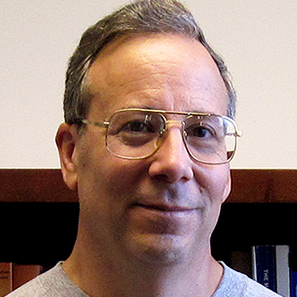
Education
- NIH Postdoctoral Fellow, University of Virginia, 1990-1991
- Postdoctoral Research Associate, University of Virginia, 1988-1990
- PhD, Indiana University, 1988
- BS, Murray State University, 1984
Research
Elucidation of the structure, function, and mode of action of metallobiomolecules.The elucidation of the structure, function, and mode of action of metallobiomolecules via: 1) spectroscopic, magnetic, kinetic and biochemical studies of the natural systems and 2) the synthesis and characterization of biomimetic inorganic complexes.
Our research applies biochemical and synthetic and physical inorganic methods to characterize the function and properties of metallobiomolecules (naturally occurring molecules such as proteins, sugars, etc. that contain tightly bound metal ions). The presence of the metal ions gives these species unique magnetic and spectroscopic properties (such as color) that provide avenues (not available to the study of simple proteins, etc.) by which we can examine these compounds in detail. Techniques involved include a variety of chromatographic methods; gel electrophoresis; mass spectrometry; electronic, Raman, electron spin resonance, IR, UV-visible, X-ray absorbance and nuclear magnetic resonance spectroscopies; and an assortment of synthetic methods.
Currently our efforts are focussed on the elucidation of the role of chromium in diabetes and the maintenance of proper carbohydrate and lipid metabolism and on the use of metalloprotein affinity metal chromatography.
We have recently shown that the oligopeptide chromodulin (or also known as low-molecular-weight chromium-binding substance, LMWCr) binds to insulin receptor in response to insulin; this results in an increase of the ability of insulin to signal cells that blood glucose concentrations are high. This may be related to adult-onset diabetes (90% of all diabetes cases in the United States), where body tissues become insensitive to insulin. We have also developed a synthetic biomimetic for chromodulin; this comple, called Cr3, has been shown to lower total blood cholesterol levels in rats by 30% and LDL cholesterol by 40%, and may have potential in the treatment of the symptoms of adult-onset diabetes.
At present, it is extremely difficult to selectively remove metal ions from dilute aqueous solutions of mixed metal ions. Metalloprotein affinity metal chromatography uses Nature’s own tricks for accomplishing this process to selectively remove and recover metal ions from waste streams. Current efforts are focussed on the removal of actinide ions (uranium, plutonium, etc.) using the metal transport protein transferrin covalently attached to chromatography supports.
Selected Publications
- Effects of bitter melon and a chromium propionate complex on symptoms of insulin resistance and type 2 diabetes in rat models. Pandora E White, Ewelina Król, Artur Szwengiel, Małgorzata Tubacka, Dawid Szczepankiewicz, Halina Staniek, John B Vincent, and Zbigniew Krejpcio, Biol. Trace Elem. Res. 2021, 199, 1013-1026.
- Molecular structure of binary chromium(III)-DNA adducts. Silas Brown, Molly Lockart, C. Sumner Thomas, Michael K. Bowman, Stephen A. Woski, and John B. Vincent. ChemBioChem 2020, 21, 628-631.
- A mechanistic study of enhanced protonation by chromium(III) in electrospray ionization: A superacid bound to a peptide. Rudradatt R. Persaud, Nnenna E. Dicke, Xinyao Jing, Skyler Lambert, Nicholas Pursa, Elizabeth Hartmann, John B. Vincent, Carolyn J. Cassady, and David A. Dixon. J. Am. Soc. Mass. Spectrom. 2020, 31, 308-318.
- Release of trivalent chromium from serum transferrin is sufficiently rapid to be physiologically relevant. Kyle C. Edwards, Hannah Kim, and John B. Vincent. J. Inorg. Biochem. 2020, 202, 110901.
- Significance of conformation changes during the binding and release of chromium(III) from human serum transferrin. Kyle C. Edwards, Hannah Kim, Riley Ferguson, Molly M. Lockart, and John B. Vincent, J. Inorg. Biochem. 2020, 206, 111040.
- X-ray Structure of Chromium(III)-containing Transferrin. Courtney M. Petersen, Kyle C. Edwards, Nathaniel C. Gilbert, John B. Vincent, and Matthew K. Thompson, J. Inorg. Biochem., 2020, 210, 111101.
- Electron paramagnetic spectrum of dimanganic human serum transferrin. Molly M. Lockart, Kyle C. Edwards, John B. Vincent, and Brad S. Pierce, Polyhedron 2021, 203, 115224.
- Examining the potential formation of ternary chromium-histidine DNA complexes and implications for carcinogenicity. Emma Lankford, C. Sumner Thomas, Sydney Marchi, Silas Brown, Stephen A. Woski, and John B. Vincent, Biol. Trace Elem. Res., in press (DOI 10.1007/s12011-021-02743-w).
- Low-molecular-weight chromium-binding substance (LMWCr) may bind and carry Cr(III) from the endosome. Kyle C. Edwards, Michael W. Gannon, Patrick A. Frantom, and John B. Vincent. J. Inorg. Biochem. 2021, 223, 111555.
- Chromium. John B. Vincent. Present Knowledge in Nutrition, 11th ed. Bernadette Marriott, Diane Birt, Allison Yates, and Virginia Stallings, Eds. Elsevier, Amsterdam, 2020, Vol. 1, 457-465.
- Benefits of Trivalent Chromium in Human Nutrition? John B. Vincent. Metal Toxicology Handbook. Debases Bagchi and Manashi Bagchi, Eds. CRC Press, Boca Raton, FL, 2021, pp. 147-160.
- Chromium. John B. Vincent. Health Care Professions Guide to Dietary Supplements. Taylor C. Wallace and Betsy Hornick, Eds. Scholastica, Chicago, IL, in press.
- Chromium. John B. Vincent. Encyclopedia of Human Nutrition, 4th Ed. Benjamin Caballero, Ed. Elsevier, Amsterdam, in press, https://doi.org/10.1016/B978-0-12-821848-8.00001-9.